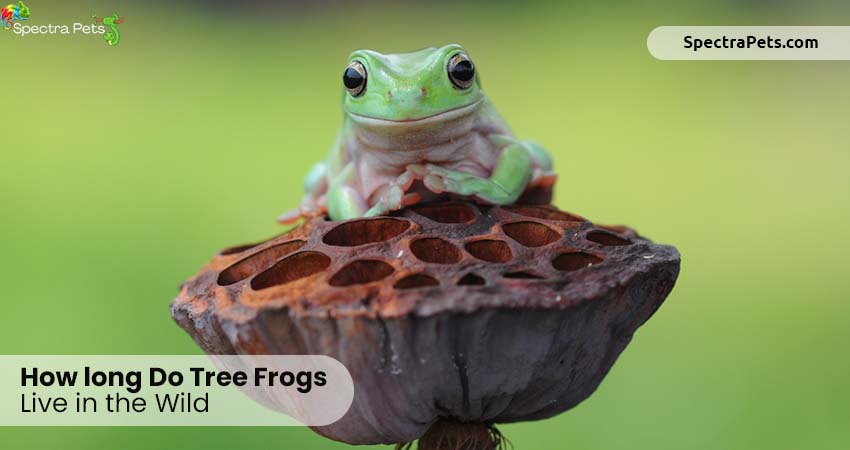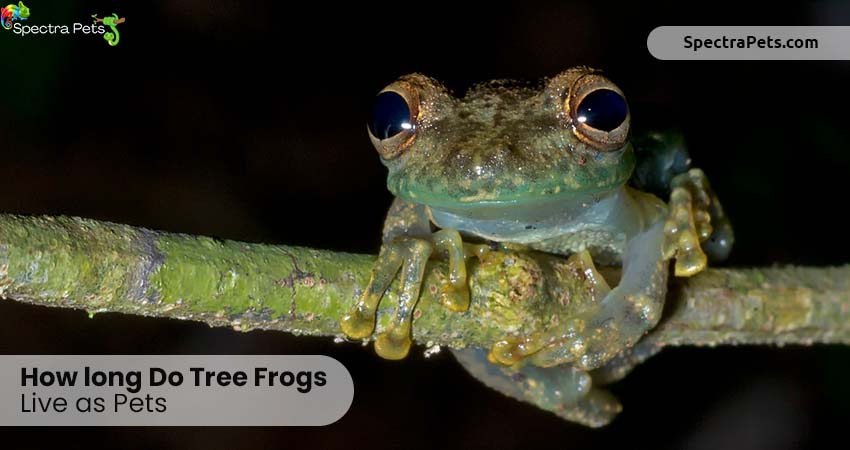The United States of America is home to a vast majority of tree frog species. These frogs are different from most other frogs in the way that they spend most of their lifetime on trees and vegetation, hence the name. In recent times, these amphibians have gained immense popularity as pets because of their vivid colors, easy maintenance, and longevity.
Tree frogs generally have a decent lifespan, living anywhere between 6 months to 20 years. Their longevity is heavily dependent on various things, such as their species, habitat, and diet. Because they are well-cared for and protected from predators in captivity, most tree frogs live longer than they would in the wild.
Are you interested in learning more about how long tree frogs actually live? In this article, we’ll have a more detailed look at the lifespans of different tree frog species in the wild, as well as in captivity.

How long do tree frogs live in the wild?
The lifespan of tree frogs in the wild can be from as low as 3 months up to 9 years. How long they actually live varies between many species. Many of them are often easily preyed upon in the wild, while others have excellent camouflaging abilities to hide themselves. The ones that live no longer than 3 years are known as short-lived.
Below, I will mention the lifespan of a few different known tree frog species living in the wild :

| Name | Scientific Name | Lifespan in the wild |
| Green Tree Frog | Dryophytes cinereus | about 7 years |
| Spring Peeper | Pseudacris crucifer | 3 to 4 years |
| Gray Tree Frog | Hyla versicolor | 7 to 9 years |
| Northern Cricket Frog | Acris crepitans | 10 to 11 months |
| Southern Cricket Frog | Acris gryllus | 4 months |
| Pine Woods Tree Frog | Hyla femoralis | up to 4 years |
| Squirrel Tree Frog | Hyla Squirella | 5 years |
| Barking Tree Frog | Dryophytes gratiosus | 5 years |
| Little Grass Frog | Pseudacris ocularis | about 4.5 years |
| Cuban Tree Frog | Osteopilus septentrionalis | 3 to 4 years |
| White’s Tree Frog | Litoria caerulea | 7 years |
| Red-eyed Tree Frog | Agalychnis callidryas | 5 years |
| Bird-voiced Tree Frog | Hyla avivoca | about 2.5 years |
| Southern Chorus Frog | Pseudacris nigrita | 1 year |
| Brimley’s Chorus Frog | Pseudacris brimleyi | 1 year |
| Mountain Chorus Frog | Pseudacris brachyphona | 1 year |
| Upland Chorus Frog | Pseudacris feriarum | 1 year |
| Ornate Chorus Frog | Pseudacris ornata | 1 year |
| Morelet’s Tree Frog | Agalychnis moreletii | 2.5 years |
How long do tree frogs live as pets?

Captive tree frogs generally have a longer lifespan than those in the wild. This is because pet owners nurture them properly. Bigger species are known to have longer lifespans than smaller ones.
Now, I will state the lifespan of a few different known tree frog species living in captivity:
| Name | Scientific Name | Lifespan in captivity |
| Green Tree Frog | Dryophytes cinereus | up to 16 years |
| Spring Peeper | Pseudacris crucifer | 4 years |
| Gray Tree Frog | Hyla versicolor | about 7 years |
| Northern Cricket Frog | Acris crepitans | 4 to 5 years |
| Southern Cricket Frog | Acris gryllus | up to 5 years |
| Pine Woods Tree Frog | Hyla femoralis | 4 years |
| Squirrel Tree Frog | Hyla Squirella | up to 8.5 years |
| Barking Tree Frog | Dryophytes gratiosus | up to 10 years |
| Little Grass Frog | Pseudacris ocularis | up to 9 years |
| Cuban Tree Frog | Osteopilus septentrionalis | 9,5 years |
| White’s Tree Frog | Litoria caerulea | up to 16 years |
| Red-eyed Tree Frog | Agalychnis callidryas | 8-12 years |
| Bird-voiced Tree Frog | Hyla avivoca | up to 4 years |
| Southern Chorus Frog | Pseudacris nigrita | up to 3 years |
| Brimley’s Chorus Frog | Pseudacris brimleyi | up to 3 years |
| Mountain Chorus Frog | Pseudacris brachyphona | up to 3 years |
| Upland Chorus Frog | Pseudacris feriarum | 5 years |
| Ornate Chorus Frog | Pseudacris ornata | up to 5 years |
| Morelet’s Tree Frog | Agalychnis moreletii | over 5 years |
How to maximize the lifespan of a tree frog in a captive environment?
It is possible to significantly extend your pet tree frog’s lifespan in captivity by following specific procedures.

- Housing:
Selecting the right enclosure is crucial for your tree frog’s well-being. A closed glass terrarium is ideal, as it helps maintain the necessary humidity levels for your pet. Additionally, ensure that each frog has adequate space to move around and explore. Overcrowding can lead to stress and health issues. To provide proper airflow and prevent your tree frog from escaping, cover the terrarium with a mesh-patterned net or lid.
- Humidity:
Tree frogs require a high level of humidity to thrive. Use organic substrate and live plants in the terrarium to help maintain humidity. Moss, coconut fiber, and bark are excellent substrate choices. Misting the terrarium lightly with water using a spray bottle will also help maintain moisture levels. Be sure to monitor the humidity within the enclosure and adjust your misting frequency accordingly.
- Diet:
A varied diet is crucial for promoting growth and longevity in your tree frog. Offer a range of insects, such as crickets, fruit flies, and small worms, based on your frog’s size and age. Most tree frogs are nocturnal, so it’s best to feed them at night when they’re most active. Avoid feeding insects that are larger than the distance between the frog’s eyes to prevent choking hazards. Supplementing insects with calcium powder before feeding can also improve your pet’s overall nutrition.
- Lighting and Temperature:
Proper lighting and temperature are essential for your tree frog’s health and well-being. Tree frogs need a consistent day-night cycle. If your frog’s enclosure is in a room without natural sunlight, use a white light on a timer for 12 hours to simulate the day-night cycle. Additionally, consider installing ultraviolet (UV) lights, as they can enhance growth, reproduction, and appetite in your pet.
Maintain the appropriate temperature gradient in the terrarium. Tree frogs usually require a temperature range of 70-80°F (21-27°C) during the day and slightly cooler temperatures at night. Use a thermometer to monitor the temperature and make adjustments as needed.
- Cleanliness:
Regular cleaning of the terrarium is vital for preventing diseases and maintaining a healthy environment for your tree frog. Remove any waste, uneaten food, and debris daily. Perform a thorough cleaning of the enclosure, including disinfecting surfaces and replacing the substrate, at least once a month.
Provide clean water for your tree frog, as they absorb water through their skin. This is crucial for reducing the risk of diseases and infections. Use a shallow water dish and replace the water daily.
Frequently Asked Questions (FAQ)
What is the average lifespan of a tree frog?
The average lifespan of a tree frog in the wild is typically 5 to 10 years. However, some species can live up to 15 years or more under ideal conditions. In captivity, tree frogs may live even longer, with proper care and a suitable environment.
Do all tree frog species have the same lifespan?
No, the lifespan of tree frogs can vary depending on the species. Some tree frogs, like the Red-eyed tree frog (Agalychnis callidryas), can live up to 5 years, while others, such as the White’s tree frog (Litoria caerulea), can live up to 16 years in captivity.
Can tree frogs live for 100 years?
As of yet, there is no tree frog species known to live for 100 years.
How long do White’s Tree Frogs live?
The White’s Tree Frog actually has the longest lifespan among all tree frogs, living up to 7 years in the wild and almost 2 decades in captivity.
How long do Red-eyed Tree Frogs live?
These frogs can live up to 12 years as pets and up to 5 years in the wild.
How long do Green Tree Frogs live?
American Green Tree Frogs live up to 7 years in the wild, and can live for as long as 16 years in captivity.
What is the longest living tree frog species?
The longest living tree frog species is the Australian green tree frog, which can live up to 20 years in captivity.
What is the natural habitat of tree frogs?
Tree frogs are primarily arboreal, meaning they spend most of their time in trees. They inhabit various environments, including rainforests, temperate forests, and swamps. The specific habitat depends on the species, but generally, they can be found in areas with ample vegetation, moisture, and food sources.
What are the main predators of tree frogs, and how do they affect their lifespan?
The main predators of tree frogs include snakes, birds, mammals, and even larger frogs. Predation is a natural part of their life cycle and contributes to their relatively short lifespan in the wild. In captivity, protection from predators can contribute to a longer lifespan.
How do tree frogs reproduce, and does it impact their lifespan?
Tree frogs reproduce through external fertilization. The female lays eggs, usually on leaves or in water, and the male fertilizes them. The time it takes for eggs to hatch and tadpoles to develop into adult frogs can vary depending on the species. Reproduction does not significantly impact the lifespan of tree frogs.
Wrapping up
There are numerous species of tree frogs, and their lifespans range from a few months to a couple of decades, depending on their size, climate, and whether they are wild or captive.
The White’s Tree Frog has the longest life expectancy, surviving up to 20 years in captivity or 7 years in the wild, while the Northern and Southern Cricket Frogs have the shortest, living only a few months in the wild. Most wild chorus frogs don’t make it past their first year, when they breed just once.
Now that you know about how long tree frogs live, why not learn about them a bit more? Like, do they hibernate? Can they even swim?. Or, what species can you pair them with so they can live together?
